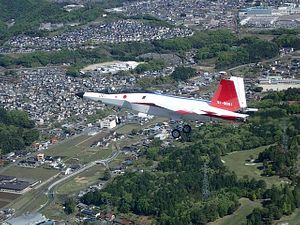Japan’s Acquisition, Technology & Logistics Agency (ATLA) plans a one-year test campaign for Mitsubishi Heavy Industries’ experimental fifth-generation fighter technology demonstrator X-2 “Shinshin” (formerly the ATD-X), Flight Global reports.
The one-year test campaign will involve around 50 flights, according to Hirofumi Doi, the manager of the Future Fighter Program at ATLA, which is part of Japan’s Ministry of Defense. Talking about the X-2’s maiden flight on April 22 (See: “Japan’s New 5th Generation Stealth Fighter Jet Makes Maiden Flight”), Doi said: “It was a very ordinary maiden flight. The pilot just checked controllability and did some simulated landings while in the air.”
As I reported previously:
The X-2 painted in red and white colors took off from Mitsubishi testing center located at Nagoya aiport in Aichi Prefecture at 8:47am local time on Friday morning and flew for about 50 kilometers (31 miles) to Gifu Air Field, an airbase of the Japan Air Self-Defense Force, situated in the neighboring prefecture of Gifu, where it landed at 9:13 a.m. (See videos here and here). During the brief test flight the aircraft performed a number of flight characteristics trials.
The test was a milestone for Japan’s indigenous aerospace industry as Japan became the fourth nation to test-fly an indigenously-developed stealth aircraft. Although Mitsubishi Heavy Industries is the primary contractor that developed the aircraft’s fuselage, more than 200 Japanese firms contributed to the design and development of the stealth fighter jet technology demonstrator.
Discussing the one-year test campaign, Doi explained that should the need arise, it could be extended beyond the initial planned 12 months. “[An extension] definitely could happen,” he said, according to Flight Global. “It depends on the data we get. If we want more data on stealth or something else we may have to extend the campaign.”
In 2011, Japan made the decision to purchase 42 F-35 Lightning II Joint Strike Fighters, the first of which are slates for induction into the Japan Air-Self Defense Force at the end of 2016. Doi stressed that the F-35 procurement is not ideal given that Japan will not have access to the most sensitive U.S.-made technology. “With the F-35 program we are not allowed access to the highest technologies that the U.S. has,” he said.
Doi stresses that despite the costs—Japan has spent around 39.4 billion yen ($332 million) on the development of the aircraft—developing the aircraft will be a boon to the country’s defense industry: “Our experience can tell you that development programs help our defense industry and can increase capabilities, knowledge, and skills.”
Japan will have to decide within the next two years whether it will develop out of the X-2 prototype–only one full-scale prototype has been assembled so far–an indigenously-designed fifth-generation air superiority fighter, dubbed the F-3.































